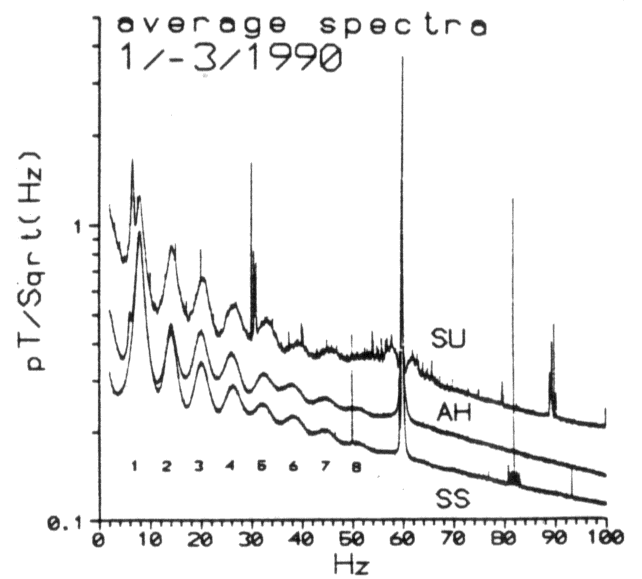
The 6-60 Hz transition zone between ULF and ELF time variations of the natural electromagnetic environment (ULF/ELF range) is characterized by the Earth-ionosphere cavity (or Schumann) resonances (see figure). These resonances result from the interference of propagating waves within the spherical shell bounded by the conducting Earth and the ionosphere, denoted Earth-ionosphere cavity. Time-series of the electromagnetic field components show a weak natural noise background and superimposed discrete events.
The Earth-ionosphere cavity resonances are mainly
excited by
atmospheric sources ,
i.e. tropospheric
lightning activity
in continental
thunderstorms ocurring in the tropical belt
around the world. However,
interference of lightning activity with
magnetospheric sources
has been adressed but little experimental evidence
has been reported so far.
The Earth-ionosphere cavity resonances may be described statistically by the solutions of a linear dynamic system which is excited by continous random noise and filters out the Earth-ionosphere cavity resonances in a mean sense. The analysis of the linear dynamic system with the Prony algorithm results in a set of excitation- and internal system-parameters. While the derived amplitudes describe the excitation mechanism, the damping and frequency are related to internal properties of the Earth-ionosphere cavity.
The first public Earth-ionosphere cavity resonance observatory is operated by the Department of Materials Science and Mineral Engineering at UC Berkeley in close collaboration with the Seismographic Station Berkeley. Their instrumentation performs continous electromagnetic field measurements and the incoming data stream is characterized by magnetic activity (MA) indices and the Earth-ionosphere cavity resonance parameters, both available at http://quake.geo.berkeley.edu/ncedc/em.intro.html